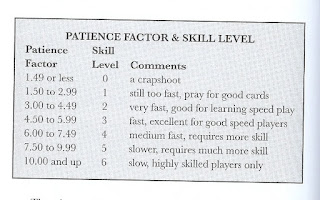Yesterday I posed this question: In a poker tournament, would you rather have 20,000 in chips and 20-minute blind levels or 12,000 in chips and 30-minute levels. My guess would have been that it's pretty close - one factor compensates for the other.
Arnold Snyder proposes something he calls the Patience Factor. In his book, The Poker Tournament Formula, he determines the speed of a tournament (using the PF), then suggests strategies on how to play given that information. When a tournament is fast, a good player must take more chances. It's a mistake to wait for good hands. On the other hand, it's a mistake to play too recklessly when the tournament is a slow one.
Here's how Snyder determines a live tournament's speed. He assumes you play about 10 hands per 20 minutes (obviously you have to adjust if automatic shufflers are used, tables are short-handed or playing online). He then sees how long it would take a player to be blinded off if he never played a hand. He then takes that figure (in terms of hours with a decimal) and squares it. The resulting number is the PF.
Tournaments have a PF of 1.49 or less are a total crapshoot. He says they have a skill level of 0. Tournaments with a PF of 1.5 to 2.99 are fast. He says pray for good cards, and assigns this a skill level of 1. There are more numbers (see chart below), but the really good tournaments have a PF of 10.0 and up and have a skill factor of 6.
Using Snyder's method, you would last 3.3 hours in the Saturday tournament with 12K in chips and 30-minutes levels. Squaring it gives it a PF of 10.9 which means it's a superb tournament.
Doing the same thing for the Sunday tournament with 20K in chips and 20-minute levels, a player would last 2.8 hours if he never played a hand. Squaring it gives 7.84. This isn't as good as the Saturday tournament, but is still a pretty good one.
Above: Snyder's classification of tournaments based on his Patience Factor.

It all depends on what the blind levels actually are...
ReplyDeleteThe two had the same blinds. 50/25 then 100/5 then 200/100 then 400/200/25 etc.
ReplyDeleteFascinating! Will definitely refer to this when selecting my next tournament. Thanks MOJO!
ReplyDeletePatrick
Another factor is whether or not the tourn has antes and when they come into play. Does he factor that in as well?
ReplyDeleteHow many hands less does he figure if it is hand shuffled?
Good stuff, MOJO.
@Rob: Snyder counts the antes (as did I). He uses hand shuffled figures of 10 deals per 20 minutes. If they use automatic shufflers, he says add 5% to the PF.
ReplyDeleteIts a really good read and has helped me a lot though my results do not necessarily back that up. I need to get it on my ereader so I can refer to it whenever I need to.
ReplyDelete